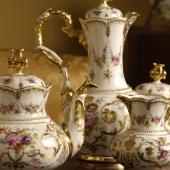Goldsmithing
Gold is a hell commodity. Gold does not oxidize, that is it does not rust. It can always get melted down without losses. This circumstance, however, has also led to the situation that many gold works from history no longer exist, since they were melted down in bad times and had to serve as means of payment. We dedicate ourselves today to the art of goldsmithing.
Pure gold is very expensive. It can often be cheapened by certain casting techniques. If one combines gold with palladium and nickel, one obtains white gold. A compound with aluminum results in ruby gold. The so-called Brinell hardness determines the hardness of gold. Gold on the one hand side can get cheapened, on the other hand it can also get discolored.
The history of goldsmith's art in Europe began in the fifth millennium BC. There are ritual gold objects detectable in the ancient Varna culture. In Egypt, at that time there already were gold works. Even today, you can admire the impressive sarcophagus of Pharaoh Tutankhamen with its gold work. Even with the Incas, Mayas and the Aztecs of South America gold played an important role. In South America, there was the "El Dorado" of gold. In the Middle Ages, the Spanish arrived in the region and were amazed: Gold galore. Unfortunately, today there are only a few remnants. As mentioned above, many goldsmith arts of the Andes were melted down by Europeans. In Europe, mostly earrings, tiaras, necklaces and belts made out of bronze were manufactured. These then were refined with fine gold flakes out of gold and granulation.
The goldsmith's art had an impressive time in the Roman Empire. Through a variety of new techniques, the smiths processed precious metals, precious stones, pearls and enamel to magnificent objects and this way decorated imperial palaces. Especially in Byzantium, later Constantinople today´s Istanbul the craft of goldsmithing flourished. Here a very oriental and filigree gold work evolved.
In northern Europe, goldsmiths were highly regarded. They decorated arms with animal motifs, which combined with abstract ornaments. Even in Christian faith and the monasteries, Christian rulers were good contracting authority for goldsmiths. Let us take a leap to the Gothic era. Between the 13th and 15th centuries, Gothic primarily focused on verticalization. The goldsmith that time no longer used enamel. The Gothic period was a very sad time, also because the plague at that time spread and death raged in Europe. Not least due to this sadness, in Gothic times especially silver was processed instead of gold.
With the Renaissance around 1450, the modern age began. The church lost its influence. The princes and kings of that time let their palaces and magnificent buildings decorate in an extravagant way. Typical of the baroque style then were grinding, baroque foliage and enamel painting. Known patterns in jewelry design were watches and beetles, which should represent the earthly transience. In rococo, the baroque mindset spread. Extreme pomp and wealth graced the jewelry that time.
The styles of Classicism, Jugendstil and Art Deco were still in between modernity and the present. A return to clear shapes and lines began. Art Deco in the goldsmith's art then distinguish itself by intense colours and contrasts as well as by exact shapes and angles. Modernity started with industrialization. A variety of goldsmithing techniques were added that provided the artists the freedom for modern designs and innovative shapes. The trend towards industrialization and mass production, up to luxury brands and designer labels will continue.




